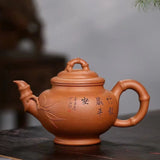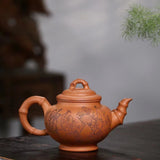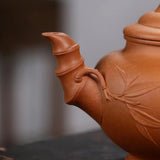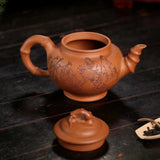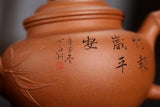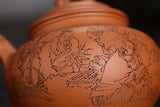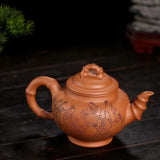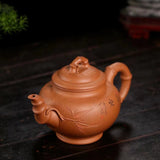Zisha teapot Bamboo Xiao Ying, handmade by artist Level 2, MU Ming-Long 穆明龙(L2-2019)稀有蟹黄段泥"笑樱竹节" (收藏重器)
壶名:笑樱竹节
泥料:稀有蟹黄段泥
容量:880 ml (收藏重器)
刻绘:少石
The Shape
The Smiling Cherry Teapot, originating from the Ming Dynasty, was refined by Master Gu Jingzhou and stands as one of the classic teapot shapes in Yixing clay art.
As early as the Song Dynasty, the "yingping" was used as a vessel for serving wine among literati; according to the "Shuowen Jiezi", it refers to a type of pottery with a large belly and a small mouth. In the Ming Dynasty, Master Xu Youquan integrated the image of the "yingping" into Yixing teapots. Due to the small size of the teapots produced, they were dubbed "xiao yinghu" or "small yinghu".
After graduating from university in 1964, Mr.Pan Chunfang, joined the technical department of The Yixing Zisha Factory and made his first assignment, an improved version of the "xiao yinghu". Based on Pan's design, Grand Master Gu JingZhou refined it into the exquisite teapot we see today.
Around 1966, during the normalization of Sino-Japanese relations, Premier Zhou Enlai wished to present a Yixing teapot to the Japanese Prime Minister. After selecting from several options, he felt that the name of this teapot needed improvement. Hence, he consulted Professor Gao Zhuang of the Central Academy of Fine Arts and Gu Jingzhou. When viewed from the side, the teapot resembles a smiling woman, radiating joy. Its knob resembles a cherry blossom bud, and given Japan's reverence for cherry blossoms, it was renamed the "Smiling Cherry Teapot".
The Smiling Cherry Teapot has gained widespread popularity due to its remarkable dynamism, appreciated for its solid and robust structure, exhibiting both a rugged masculinity and the grace of a refined lady. According to Master Gu Jingzhou, crafting this teapot requires meticulous attention to detail.
Among the numerous Smiling Cherry Teapots, many are the works of masters. Wang Yinchun, Zhu Kexin, and Gu Jingzhou, three of the "Seven Grand Masters of Zisha", produced similar creations in the 1960s and 1970s. Their individual interpretations of proportions in the teapot's height, spout, handle, and lid result in distinct nuances.
Among them, the most renowned are the works of Master Gu Jingzhou's Smiling Cherry Teapot: slightly flattened with rounded folded shoulders, its robust form, and smooth lines highlight its plump and gentle beauty. Crafted from natural pure purple clay, its fine texture, rich purple hue, and lustrous finish make it a treasured representative of teapot art.
器型
笑樱壶始于明代,改良自顾景舟大师,是紫砂壶中的经典壶型之一。
早在宋代,罂瓶用作文人雅士的盛酒器;《说文》:“罂,缶也”。是为大腹小口的瓦器。
明代,紫砂大师徐友泉把罂瓶的形象,融入到紫砂壶中,因为制出的紫砂壶很小,没有罂瓶大,所以就被称为“小罂壶”。
朱可心的徒弟,潘春芳大学毕业之后,1964年到了紫砂厂的技术科,做的第一件作品便是改进“小罂壶”,也称之为“小英壶”。
顾老依据潘春芳的设计,改进成为目前的这款万分出彩的壶型;
1966年左右,中日建交时,周总理想把宜兴的紫砂壶赠送给日本首相,从数款中选了这款,但觉得其壶名有待改进,便与当时参与其事的中央美院高庄教授和顾景舟商讨,这款壶从侧面看,好似一女子在笑,充满喜悦之情,花苞壶纽形意似枝头樱桃,加上日本以樱花为尊,就改名为“笑樱壶”。
笑樱壶流传甚广,皆因其张力十足,为人所喜爱。
器型沉重扎实,有种绝不妥协的硬汉风格,又有小女子大家闺秀的风韵。
根据改良者顾景舟大师的观点,制作这款壶型其实是非常考工夫的。
众多的笑樱壶中不乏大师的作品,“紫砂七大老艺人”中的王寅春、朱可心、顾景舟在上世纪六七十年代都有类似的创作,因各自对壶体高低,壶流、壶把、壶盖等比例的理解不同,而展现出不同的韵味。
其中最有名气的就是顾景舟大师的笑樱壶作品:微扁圆折腹隆肩,形体雄健线条流畅,特显丰满柔和之美。选用天然纯紫泥而作,泥质细而不腻,色泽紫而不姹,润泽腴丽,是壶艺光素器的珍品代表。
泥料
蟹黄泥,被称之“老团泥”,产于江苏省宜兴黄龙山,原矿外观近白色,夹深绿斑点;除可当泥胚陶外,亦可磨筛成细颗粒,作为调砂效果之用;烧成后呈次鹅黄色,略含极少数红色斑点。
另一段泥之原矿为本山绿泥,产地亦为黄龙山,原矿呈绿灰色,是紫砂泥中夹层中的夹脂,烧成后呈米黄色调。泥料内所含颗粒较大结构疏松器身明显成双气孔结构,空气对流顺畅;早期泥料调配跟早期窑炉所升温度较低温,在一般段泥产品会近期来所用窑炉为高温窑,所烧成之段泥壶,可轻易提升至所须温度,而真正达到较高的结晶。
【窑温】约1175~1180度
【收缩比】约12%
【矿产地】江苏宜兴
【泥性】质坚而温润,呈近田黄色调,为共生矿,经挑拣炼制而成,因含铁量只达6%左右,制陶之后呈“金田黄色”
【冲茗特性】段泥适泡之茶较为宽广,一般而言,透气率好;茶汤顺和平适,操作冲茗技巧要求不高,适生手使用
【冲泡建议】普洱茶系列,重发酵茶类(黑茶类),乌龙茶,绿茶,红茶等。
作者
穆明(民)龙,男,1964年生于宜兴。
LEVEL 2,国家高级工艺美术师。(Awarded in 2019).
国家高级泥料工程师
中国工艺美术学会会员
蒋蓉(Level 1A)国大师的外甥。
1989年创办宜兴丁蜀紫砂工艺厂至今,一直从事紫砂原料及壶艺的设计创作。
钻研紫砂壶的造型和制作工艺,得心应手。由壶艺界高手指点,特别是受紫砂艺术泰斗之一、姨妈——蒋蓉大师指教,紫砂壶的造型和制作工艺日趋成熟、精湛,对传统手法的掌握颇有特点,注重对泥料的创新研制,在壶艺界以独特的创制作手法著称。其作品原料精选自自然天然紫砂泥料,作品风格融古铸今,古朴典雅,线条流畅优美,别具一格,自成一派。
作品曾多次参加海内外大型展评会,并获得多项金银奖项。作品也曾被多家国家级博物馆收藏。中国嵩山少林寺曾指名收藏其作品《心连一体壶》、《小泉流水壶》、《兆本砂壶》。
穆老师近期来研制出超强透气性紫砂原矿料“紫玉龙砂土”,采用这天然原矿坭料,经过坭配坭的工序流程,以最原始、最自然的紫砂坭料为主,别具一格、熔古铸今形成了自己的特色光壶古朴、典雅、线条优美。作品以传统手法见长,功力深厚,制作工艺精湛,并注重创新,特别是紫砂坭料的不断翻新,立意求变,终于成功研制出超强透气性“紫玉龙砂土”。
当往“紫玉龙砂土”制成的砂壶里注上沸水,可见一股淡淡的雾气从壶身上缓缓升腾,同时,仔细观察壶中的茶水, 可见有一些微小的气泡产生,这说明茶水能产生增氧富氧作用,也可见茶壶的透气性非同一般。用此砂壶泡的茶,长时间饮用会更加有益于人们的健康长寿,在紫砂创新的方法上著称于当代壶艺界。








